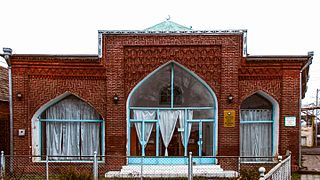
Quba District is one of the 66 districts of Azerbaijan. Located in the northeast of the country, it belongs to the Guba-Khachmaz Economic Region. The district borders the districts of Qusar, Qabala, Ismayilli, Shamakhi, Shabran, and Khachmaz. Its capital and largest city is Quba. As of 2020, the district had a population of 173,400.

Quba is a city and the administrative centre of the Quba District of Azerbaijan. The city lies on the north-eastern slopes of Shahdag mountain, at an altitude of 600 metres above sea level, on the right bank of the Kudyal river. It has a population of 47,200 (2023).
The Tuba-Shahi Mosque is a historical and architectural monument of the 15th century located in the Mardakan village of the Khazar district in Baku (Azerbaijan). The mosque is included in the list of the historical and architectural monuments of local importance approved by the Cabinet of Ministers of the Republic of Azerbaijan. It was built not far from the Quadrangular Mardakan Castle dating back to the era of the Shirvanshahs.

Chokak Hamam is a historical bath near Juma Mosque in Ganja. Historical-architectural monument built in 1606, by order of Shah Abbas.

Khidir mosque is a historical mosque of the XIV century. It is a part of Old City and located on Muslim Magomayev street, in the city of Baku, in Azerbaijan. The building was also registered as a national architectural monument by the decision of the Cabinet of Ministers of the Republic of Azerbaijan dated August 2, 2001, No. 132.

Sayyid Yahya Murtuza mosque is a historical mosque of the 17th century. It is a part of Old City and located on Asaf Zeynalli street, in the city of Baku, in Azerbaijan. The building was also registered as a national architectural monument by the decision of the Cabinet of Ministers of the Republic of Azerbaijan dated August 2, 2001, No. 132.

Jinn mosque is a historical mosque of the XIV century. It is a part of Old City as well as Palace of the Shirvanshahs and located on Gala turn, in the city of Baku, in Azerbaijan. The building was also registered as a national architectural monument by the decision of the Cabinet of Ministers of the Republic of Azerbaijan dated August 2, 2001, No. 132.

The Gileyli mosque or Jomard Garay mosque is a historical mosque of 14th century located on Mirza Mansur street in the Old City of Baku in Azerbaijan. The building was registered as a national architectural monument by the Cabinet of Ministers of the Republic of Azerbaijan on August 2, 2001, No. 132.

The Molla Ahmad Mosque, also known as the Nasir ad-Din Gashtasib Mosque, is a former mosque, located on Sabir street, in the Icherisheher of Baku, the capital of Azerbaijan. Completed in 1300 CE, the former mosque was registered as a national architectural monument by the decision of the Cabinet of Ministers of the Republic of Azerbaijan dated August 2, 2001, No. 132.

The Boyuk Bazar Mosque is a mosque in the city of Lankaran, Azerbaijan. The mosque was built in 1864 in the Boyuk Bazar neighborhood.

The Kichik Bazar Mosque is a mosque and historical architectural monument located in the center of the Lankaran district of Azerbaijan. The mosque was built in 1904.

The Haji Sultanali Mosque is a historical-architectural monument dating back to the early 20th century, located in Baku, Azerbaijan.

The Giyasly Mosque is a mosque located in the village of Qiyaslı, Agdam, Azerbaijan. By the order of the Cabinet of Ministers of the Republic of Azerbaijan dated with 2 August 2001, the mosque was taken under state protection as an architectural monument of local importance.

The Ozan Mosque -(Azerbaijani Ozan məscidi ) a mosque and historical-architectural monument built in 1884, located in the city of Ganja, Azerbaijan.

The Huseynia Mosque or the Tat Mosque is a historical and architectural monument of the 19th century located in the city of Ganja, Azerbaijan.

The Galagayin Mosque is a Shia Islam mosque, located in Qalaqayın, in the Sabirabad District of Azerbaijan.

Haji Jafar Mosque is a historical architectural monument built in the early 19th century in the city of Guba, Azerbaijan.

The Haji Badal Mosque is a mosque and historical architectural monument, located in the "Basqal" State Historical-Cultural Reserve in Azerbaijan. Completed in 1854, the mosque was included in the list of local importance immovable historical and cultural monuments by the 132nd decision of the Cabinet of Ministers of the Republic of Azerbaijan on August 2, 2001.

Hil mosque is a mosque located in the village of Hil in the Qusar district of Azerbaijan.

Khanagah Mosque is a mosque and historical-architectural monument in Khanagah village of Quba District, Azerbaijan. The mosque was built in the 19th century.



















